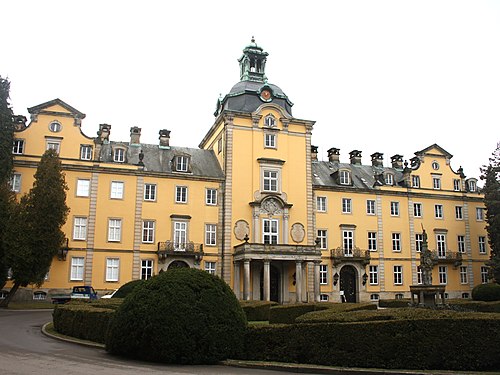You can helpexpand this article with text translated fromthe corresponding article in German.Click [show] for important translation instructions.
|
County (Principality) of Schaumburg-Lippe Grafschaft (Fürstentum) Schaumburg-Lippe (German) | |||||||||
|---|---|---|---|---|---|---|---|---|---|
| 1647–1918 | |||||||||
| Anthem: Heil unserm Fürsten, heil Hail to our Prince, hail! | |||||||||
 Schaumburg-Lippe within the German Empire | |||||||||
 | |||||||||
| Status |
| ||||||||
| Capital | Bückeburg | ||||||||
| Prince | |||||||||
• 1807–1860 | George William (first) | ||||||||
• 1911–1918 | Adolf II (last) | ||||||||
| Historical era | Early modern Europe | ||||||||
| 1647 | |||||||||
| 1777 | |||||||||
• Raised toprincipality | 1807 | ||||||||
| 1918 | |||||||||
| 1946 | |||||||||
| Population | |||||||||
• 1861 | 29,000[1] | ||||||||
| |||||||||
Schaumburg-Lippe, also calledLippe-Schaumburg, was created as a county in 1647, became a principality in 1807 and a free state in 1918, and was until 1946 a small state inGermany, located in the present-day state ofLower Saxony, with its capital atBückeburg, an area of 340 km2 (130 sq mi) and over 40,000 inhabitants.
Schaumburg-Lippe was formed as a county in 1647 through the division of theCounty of Schaumburg by treaties between theDuke of Brunswick-Lüneburg, theLandgrave of Hesse-Kassel and the Count ofLippe. The division occurred because Count Otto V of Holstein-Schaumburg had died in 1640 leaving no male heir. Initially Schaumburg-Lippe's position was somewhat precarious: it had to share a wide variety of institutions and facilities with the County of Schaumburg (which belonged to Hesse-Kassel), including the representative assembly and the highly productiveBückeberg mines, and theLandgrave of Hesse-Kassel retained some feudal rights over it. It was further threatened by the headstrong policies of the ruling Count,Frederick Christian. To counter these threats, Frederick's grandson, CountWilliam (who reigned 1748–1777) retained a standing army of up to 1000 troops – quite a lot for such a small territory.
With William's death in 1777, the junior lineSchaumburg-Lippe-Alverdissen inherited the county, thereby reuniting Schaumburg-Lippe with Lippe-Alverdissen.

Schaumburg-Lippe was a county until 1807, when it became a principality; from 1871 it was a state within theGerman Empire. In 1913, it was the least populous state in the German Empire.[2] The capital wasBückeburg, whileStadthagen was the only other town. Under the constitution of 1868, there was a legislative diet of 15 members with ten elected by the towns and rural districts, one each by the nobility, clergy and educated classes and the remaining two nominated by the prince. Schaumburg-Lippe sent one member to theBundesrat (federal council) and one deputy to theReichstag.[3] The principality lasted until theend of the German monarchies in 1918, when it became afree state as theFree State of Schaumburg-Lippe. In November 1918, Prince Adolf was the penultimate German monarch to abdicate.


 | This article aboutgovernment inGermany is astub. You can help Wikipedia byexpanding it. |
s